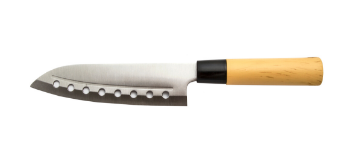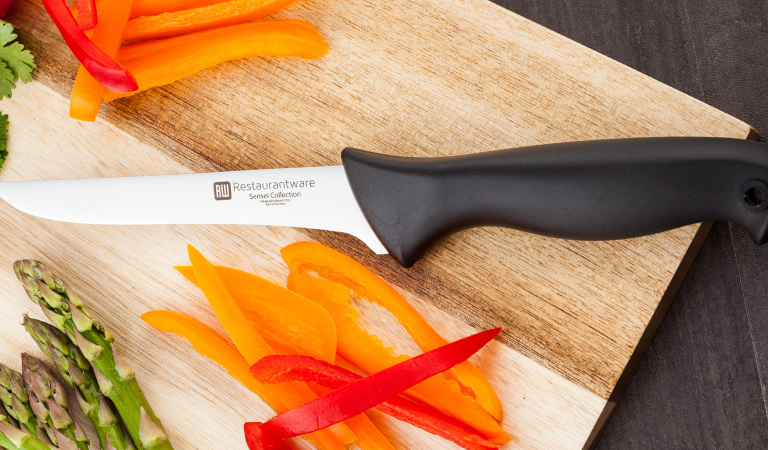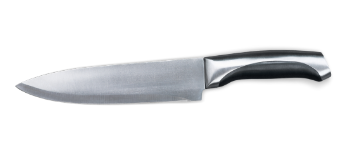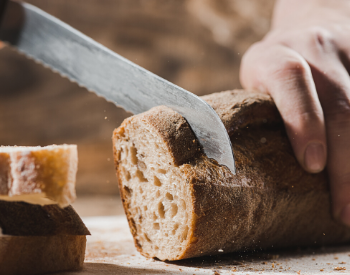You’ve probably noticed that every chef has a preference for the type of knife they like to use when chopping, slicing, dicing, or cutting ingredients. That’s because each type of knife is unique and features a number of benefits. To find what knife works best for your needs, it is essential to understand how knives are made and their differences before purchasing cutlery. In this kitchen knife buying guide, we provide you with all the information you need to find knives that best fit your needs.
Forged Kitchen Knives vs. Stamped Kitchen Knives
When shopping for commercial cutlery, you’ll notice that knives are either forged or stamped. This refers to the method used to manufacture the knife. Each manufacturing process has a number of advantages and drawbacks which makes it essential to understand their differences when purchasing cutlery for your kitchen.
How Are Forged Knives Made?
In the past, forged knives were constructed by skilled craftsmen who heated a bar of steel and hammered it into the shape of a knife. However, the process has changed over the years and most forged knives are now made with a forging machine. The machine heats and compresses the steel to form its shape and a bolster between the heel and handle. Knives are then heat-treated for strength and go through a honing process to give them their edge.
Pros:
- Have bolsters that provide you with a safe place to rest your fingers while cutting
- Feature full tangs that help balance the blade for added stability
- Have stronger blades compared to stamped knives
- Don’t need to be honed or sharpened often
Cons:
- Bolsters make forged knives thicker and heavier than stamped knives
- Blades aren’t flexible which may make it difficult to complete certain kitchen tasks
- Forged knives are typically more expensive than stamped knives
How Are Stamped Knives Made?
A stamped knife is constructed from a hydraulic press or die that cuts a large sheet of steel to form the blade’s shape. The handle is then added to the blade and the knife is honed to form its edge.
Pros:
- Stamped knives are thinner and lighter than forged knives
- Feature flexible blades that make it easy to filet foods
- The lack of a bolster allows you to comfortably complete certain tasks
- Stamped knives are usually less expensive than forged knives
Cons:
- The flexibility of the blade makes it difficult to hone or sharpen the blade
- Stamped knives don’t feature a bolster that protects your fingers from the blade
- Many stamped knives have half tangs which can make it difficult to balance when cutting ingredients
Knife Handle Materials
The handle of a kitchen knife plays a big role in food preparation. Although the blade of a knife may cut ingredients, the handle can determine your grip and the weight of the knife. Below are the different types of knife handle materials that are commonly found in commercial kitchens.
Wood
Many chefs enjoy using wooden knives because of the nostalgia associated with them and the rustic touch they add to kitchens. The wooden handle is also heavier than the blade, providing chefs with more control when slicing or dicing food.

Before purchasing wooden knives for your business, it’s essential to check health regulations in your area. Some locations do not allow the use of wooden cutlery in commercial kitchens because wood surfaces are susceptible to bacterial growth if not properly washed.
Types Of Wooden Kitchen Knives
- Rosewood
- Walnut
- African blackwood
- Bloodwood
- Olive wood
- Padauk
Plastic
Plastic knife handles are the most popular type of handles found in commercial kitchens because they are durable and easy to clean. These knives weigh less than wooden knives, allowing chefs to comfortably prep ingredients for long hours without hand fatigue. However, exposing plastic handles to extreme temperatures for long periods of time can cause them to fade or crack.
Types Of Plastic Kitchen Knives
- Acrylonitrile butadiene styrene (ABS)
- Polyoxymethylene (POM)
- Polypropylene (PP)

Stainless Steel
Stainless steel handles require very little maintenance and are easy to clean. These handles are naturally durable and corrosion-resistant to ensure they maintain their premium design when acidic foods make contact with them. Stainless steel handles also tend to be heavy, providing exceptional balance for knives with long blades.

If you’re handling a knife with a short blade, a stainless steel handle may make it difficult for you to control the knife. The handle also tends to get slippery due to its smooth surface. This can make it challenging to have a firm and stable grip on the knife if the handle or your hands are wet.
Knife Blade Materials
Chefs are very specific when it comes to the type of blade they use to complete tasks. Each blade material has its benefits and below is a breakdown of the types of blades found in a commercial kitchen.
Stainless Steel
Stainless steel blades are rust-resistant and don’t require a lot of maintenance, making them a popular choice among chefs. However, they do not hold their edge as long as carbon steel blades. Stainless steel blades need to be frequently honed to realign their edges.
When purchasing a stainless steel knife, try to find out the type of steel it was made from. Although all stainless steels have a lot of similarities, each type of steel is unique and presents its own set of benefits.
Japanese Steel
Japanese steel blades have a thin and sharp edge, allowing you to create clean and precise cuts. They also taper inside the handle which provides you with a comfortable grip and full control when cutting ingredients.
Popular Japanese Steel Kitchen Knives
- VG-10
- AUS-10
- R2
German Steel
German steel knives are heavy due to their wide and curved blade. Their thick blade allows you to complete a number of different tasks, such as cutting through bones, slicing hard foods, or chopping a variety of ingredients. Although these versatile knives are heavy, the majority of them have a bolster to provide you with control when working with ingredients.
Popular German Steel Kitchen Knives
- 420
- 420HC
- 420JC
- 440C
Carbon Steel
Carbon steel knives feature one of the sharpest blades, providing you with an effortless way to dice or slice ingredients. The sharp blade also makes it easy to sharpen or hone the blade. Carbon steel knives do have a lack of chromium which makes them vulnerable to stain and rust. These knives need to be carefully cleaned, dried, and lubricated to prevent them from rusting.
High-Carbon Stainless Steel
High-carbon stainless steel knives are one of the most popular types of knives in the kitchen. They have higher carbon content than stainless steel knives which provides them with more strength and a sharper edge. Although high-carbon stainless steel knives are naturally durable and easy to maintain, they usually cost more than stainless steel and carbon steel knives.
Damascus
Damascus knives are constructed in the forging process by layering at least two different types of steels by heat and then shaping the layers into repeated folds. This process provides the blade of Damascus knives with unique patterns which is why some chefs enjoy using them. The combination of steels also gives them a tough and durable structure, allowing you to effortlessly complete a variety of tasks.
Since these knives are constructed using different types of steel, it may cause the edges to have unique patterns that can affect their performance. It also makes it difficult to know the maintenance requirements for the edge of the blade if you’re unaware of the type of steels the knife was crafted from.
Ceramic
Ceramic blades are typically made with zirconium dioxide, which is a ceramic material that is extremely hard and durable. The material used to make ceramic knives provide the blade with a sharp edge that doesn’t need to be sharpened often. Ceramic knives are also corrosion-resistant and stain-resistant, allowing you to slice acidic foods without damaging the blade. However, ceramic cutlery is more brittle than conventional knives and requires special ceramic tools to sharpen the blade. Improperly sharpening the blade may ruin the knife.
Flexible Knife Blades vs. Rigid Knife Blades
You may notice that most chefs use knives with flexible blades and rigid blades throughout the day. That’s because a knife with a flexible blade and a stiff blade serve different purposes.
When working with a flexible blade, you’re able to easily maneuver around delicate foods without damaging them. They allow you to remove the bones of a fish or cut meat while working around bones. However, poultry or bigger cuts of meat require you to use a stiff, rigid blade. Using a flexible knife with tough meats will cause the knife to bend which may lead to injuries. A stiff blade is able to handle tough meats and cut through cartilage with ease.
Serrated Edges vs. Straight Edges
Serrated knives are specially designed to pierce the outer layer of the food you are cutting. They are ideal to cut foods with a hard exterior and a soft interior, such as bread and tomatoes. For example, cutting a loaf of bread with a straight edge is difficult and will crush the bread.
A straight edge knife is extremely versatile and used to complete the majority of your tasks. They are designed to give you a smooth cut, making them great for slicing, dicing, mincing, and chopping ingredients. Using a serrated blade to cut food will ultimately make uneven cuts and tear ingredients.
Which Knife Fits Your Needs?
With all the different types of knives out in the market, it’s important to understand how the edge, blade, or handle of the knife may affect your comfort and efficiency when prepping food. Before making a purchase, simply think about the tasks you complete on a regular basis. This will allow you to purchase the best kitchen knives for your knife set to ensure you can effortlessly cut, slice, dice, mince, or chop food.








